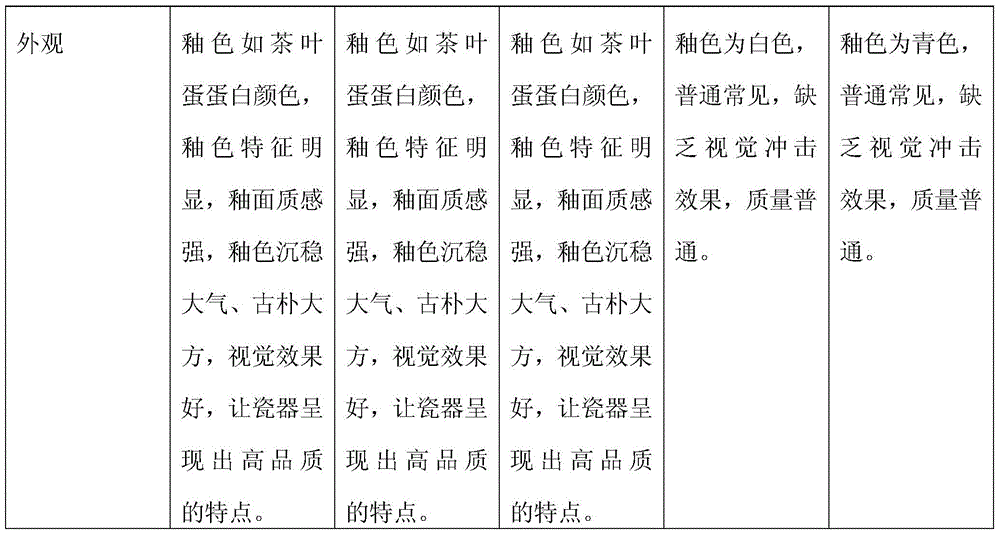Protein glaze and its firing method
A protein and glaze soil technology, applied in the field of protein glaze and its firing, can solve the problems such as the ornamental can not meet the needs of people, the glaze color is single, and the aesthetic fatigue is achieved, and the glaze color is calm and atmospheric, the glaze texture is strong, and the visual effect is good. Effect
- Summary
- Abstract
- Description
- Claims
- Application Information
AI Technical Summary
Problems solved by technology
Method used
Image
Examples
Embodiment 1
[0016] This protein glaze is made of the following raw material proportions by weight: 40 parts of yellow altar glaze soil, 5 parts of limestone, 8 parts of talc, 6 parts of feldspar, 5 parts of white clay, 15 parts of kaolin, and 4 parts of quartz .
[0017] The firing method of above-mentioned albumen glaze is:
[0018] The first step is mixing, uniformly mixing the selected yellow altar glaze soil, limestone, talc, feldspar, white mud, kaolin, and quartz, wet ball milling for 11 hours, and then passing the milled glaze through a 200-mesh sieve to obtain Glaze;
[0019] The second step is glazing. Add water to the obtained glaze to make a glaze slurry of 54 degrees Baume. Then take the porcelain blank and glaze the blank by dipping glaze. After the glaze is applied, place it in a cool and ventilated place for natural air drying. The time is 12 hours;
[0020] The third step is sintering. Put the dried blanks into the kiln for firing. When firing, the temperature of the ki...
Embodiment 2
[0022] This protein glaze is made of the following raw material proportions by weight: 50 parts of yellow altar glaze soil, 7 parts of limestone, 10 parts of talc, 8 parts of feldspar, 6 parts of white clay, 19 parts of kaolin, and 6 parts of quartz .
[0023] The firing method of above-mentioned albumen glaze is:
[0024] The first step is mixing, uniformly mixing the selected yellow altar glaze soil, limestone, talc, feldspar, white mud, kaolin, and quartz, wet ball milling for 13 hours, and then passing the milled glaze through a 210 mesh sieve to obtain Glaze;
[0025] The second step is glazing. Add water to the obtained glaze to make a glaze slurry of 62 Baume degrees. Then take the porcelain blank and apply glaze to the blank by dipping glaze. After the glaze is applied, place it in a cool and ventilated place for natural air drying. The time is 13 hours;
[0026] The third step is sintering. The dried blanks are put into the kiln for firing. When firing, the tempera...
Embodiment 3
[0028] This protein glaze is made of the following raw material proportions by weight: 60 parts of yellow altar glaze soil, 8 parts of limestone, 15 parts of talc, 10 parts of feldspar, 9 parts of white clay, 25 parts of kaolin, and 9 parts of quartz .
[0029] The firing method of above-mentioned albumen glaze is:
[0030] The first step is mixing, uniformly mixing the selected yellow altar glaze soil, limestone, talc, feldspar, white mud, kaolin, and quartz, wet ball milling for 15 hours, and then passing the milled glaze through a 220-mesh sieve to obtain Glaze;
[0031] The second step is glazing. Add water to the obtained glaze to make a glaze slurry of 68 Baume degrees. Then take the porcelain embryo and glaze it by dipping glaze. After the glaze is applied, place it in a cool and ventilated place for natural air drying. The time is 14 hours;
[0032] The third step is sintering. Put the dried blanks into the kiln for firing. When firing, the temperature of the kiln i...
PUM
 Login to View More
Login to View More Abstract
Description
Claims
Application Information
 Login to View More
Login to View More - R&D Engineer
- R&D Manager
- IP Professional
- Industry Leading Data Capabilities
- Powerful AI technology
- Patent DNA Extraction
Browse by: Latest US Patents, China's latest patents, Technical Efficacy Thesaurus, Application Domain, Technology Topic, Popular Technical Reports.
© 2024 PatSnap. All rights reserved.Legal|Privacy policy|Modern Slavery Act Transparency Statement|Sitemap|About US| Contact US: help@patsnap.com









